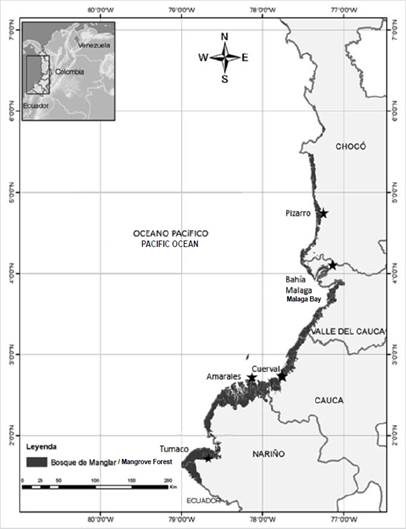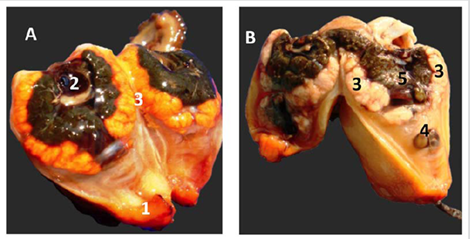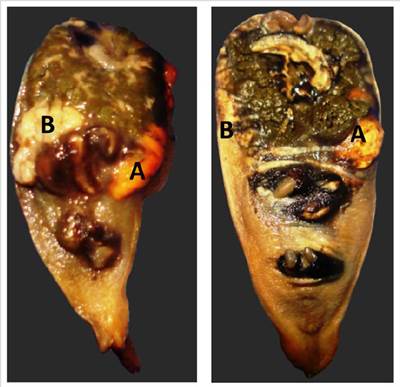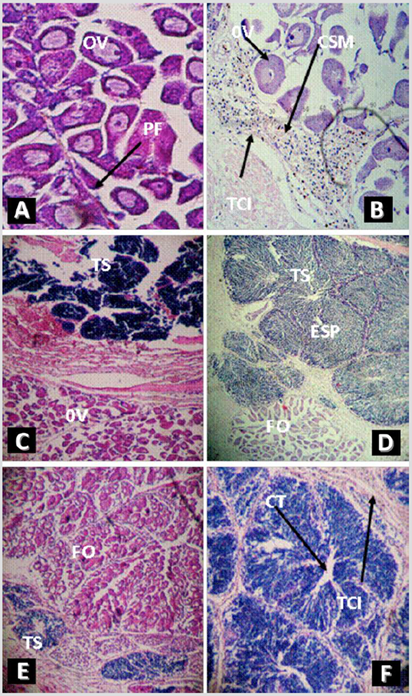Anadara tuberculosa and Anadara similis are two species of cockles of the family Arcidae that inhabit the muddy plains of mangrove areas of the Pacific coast of tropical America between Baja California and the northern coast of Peru. These bivalves are two of the most commercially important mollusks in the Eastern Tropical Pacific region, being highly exploited in the Colombian and Ecuadorian coasts (Cantera y Contreras, 1978; MacKenzie, 2001; Flores y Lincadeo, 2010; Gil-Agudelo et al., 2011; Lucero et al., 2013).
Both A. tuberculosa and A. similis lack sexual dimorphism, and sex can only be determined by direct observation of the color of the gonads and microscopic observations after dissection. Males have a white or creamed-colored gonad, while female gonads are yellow or orange (Lucero-Rincon et al., 2013; Manjarrés-Villamil et al., 2013). Although most bivalves are gonochoric or dioecious, some can be hermaphrodites or change sexes with age (Breton et al., 2017). Reproductive studies in A. tuberculosa and A. similis have shown that they spawn yearlong, although some reproductive peaks can be identified (2 to 5) depending on environmental conditions such as salinity, temperature, and precipitation (Squires et al., 1975; Herrán 1983; Cruz; 1984; Borda y Cruz, 2004; Lucero et al., 2012; Lucero-Rincon et al., 2013; Manjarrés-Villamil et al., 2013; García-Dominguez et al., 2018).
Between August 2009 and August 2010, organisms described in this paper were collected in the intertidal zone of five mangrove areas of the Pacific coast of Colombia (Figure 1). Original sampling was directed to establish the abundance and reproductive cycles of the species; thus, the present paper does not present a complete picture of the frequency of hermaphroditism on these species, but rather an approximation derive by the opportunity of the observations.

Figure 1 Study sites along the Pacific coast of Colombia. Sampling sites are denoted by a star symbol.
At macroscopic level, organisms were evaluated for sexual maturity using the methodology described by Lucero-Rincon et al. (2013). At microscopic level, organisms were preserved using buffered formaldehyde, dehydrated, and embedded in paraffin wax following traditional histology techniques (Luna, 1968). Histological analyses of transversal and longitudinal sections of a width of 7 µm (including mantle, gonad, digestive gland, intestine, and gills) were performed and stained using Hematoxylin-Eosin (Herrán, 1983; Ampie y Cruz, 1989).
The macroscopic analysis of the gonadic state of 3,545 individuals of A. tuberculosa showed that 16 individuals (0.45 %) presented signs of hermaphroditism. These individuals were observed in the locations of Cuerval (one case out of 576 individuals analyzed), Bahia Malaga (7 cases amongst 1,093 individuals), and Tumaco (8 cases in 1,071 individuals). The mean length of hermaphrodite organisms was 47.45 ± 7.74 mm, with both the largest and smallest organism registered in the Bahia Malaga site with 62.93 mm and 32.83 mm respectively. These individuals showed one elongated and thin gonad, cream in color, typical of male individuals, while the opposite gonad was bright orange, in the form of a sack, typical of female organisms (Figure 2). These organisms were considered as mature, since the gonad occupied more than 50 % of the body cavity, having irregular thick lobs that extent over the entire ventral surface from the anterior adductor muscle to the limits with the foot muscle (Figure 3). The length of the shell of the first maturity for the species in the area has been estimated at 39.5 mm (total length) and the growth curve showed that most organisms analyzed were approximately two years old (Lucero et al., 2012, 2013; Manjarrés-Villamil et al, 2013). No A. similis were macroscopically analyzed for hermaphroditism during this study.

Figure 2 Transversal dissection for macroscopic observation of coloration and gonad shape in mature organisms of A. tuberculosa in Bahia Málaga (total length = 58.0 mm). A: Female organism (orange gonad); B: Male organism (cream gonad). 1: Foot; 2: Digestive gland; 3: Gonads; 4: Intestine; 5: Hepatopancreas.

Figure 3 Transversal cut of hermaphrodite Anadara tuberculosa, showing differences in gonad coloration in the same organism. A: Orange gonad; B: Cream gonad. Organism collected in Tumaco (total lenght = 53.0 mm).
A total of 290 individuals of A. tuberculosa were analyzed using standard histological techniques, 3.1 % (9 individuals) of them showed signs of hermaphroditism. These organisms were collected in Pizarro (99 organisms analyzed with one hermaphrodite found), Bahía Málaga (35 analyzed and 4 hermaphrodite organisms), Cuerval (2 hermaphrodites out of 52 analyzed organisms), and Tumaco (104 organisms analyzed, 2 hermaphrodites). These individuals showed seminiferous tubules, germinal cells, and spermatids in variable quantities; the center of empty seminiferous tubules and the interfolicular conjunctive tissue were also clearly visible (Figure 4). Reproductive cells also presented a large nucleus in a central position, as described by Ortiz et al. (2003) during spermatogenesis. These same individuals showed, in the other gonad, follicles in development with an empty center and non-abundant oocytes inside. Some oocytes were piriform and were attached to the follicle wall, showing their development or previtelogenesis stage. Cell size varies between 37 and 74 µm, a few of these cells larger than 70 µm. Secondary oocytes showed a defined nuclear membrane and central nucleolus, indicating a transition towards mature ovules (Figure 4). Interfollicle conjunctive tissue and male sexual cells were observed bordering the follicle wall.

Figure 4 Photomicrography of Anadara tuberculosa hermaphrodite gonads. Hematoxylin-Eosin stain. A and B 10x magnification, C - F 4x magnification. TCI: Interfolicular conjunctive tissue; ESP: Spermatozoids; TS: seminiferous tubules; CTS: Center of the seminiferous tubules; FO: Ovaric follicle; PF: Follicle wall; OV: Vitteline oocytes; CSM: Male sexual cells around the follicle.
Regarding A. similis, histologic slides of 336 organisms were analyzed, finding 10 individuals (3.0 %) with signs of this condition. These organisms were collected in Pizarro (5.72 %; 4 hermaphrodites out of 68 organisms analyzed), Bahía Málaga (2.94 %; 2 cases out of 70 organisms), and Cuerval (1.8 %; two cases out of 111 organisms), as well as 2 cases in Tumaco out of 87 analyzed organisms (2.30 %). The description of reproductive tissue was similar to that of A. tuberculosa.
Hermaphrodite organisms were found to be in the previtelogénesis stage, with separate male and female gametes, and the presence, at the same time, of functional spermatozoids and ovules (simultaneous hermaphroditism). Histological analyses showed active male and female reproductive cells, indicating that organisms are reproductively functional, which has been described in other mollusks (Olivares et al., 2009). Other species of the genus Anadara have shown signs of hermaphroditism, including as Anadara granosa (Broom 1983), Anadara senilis (Broom, 1985), and Anadara scapha (Baron and Clavier, 1992), which are considered gonochoric. Mzighani (2005) analyzing 600 organisms of Anadara antiqua, found 4.7 % of hermaphrodite organisms, indicating protandrous hermaphroditism due to the dominance of females by size class (41 mm). Flores and Lincadeo (2010) suggested that a protandrous hermaphroditism of A. tuberculosa and A. similis might produce a strong variation of the sexual relation at different size classes, but provide no evidence of such changes.
Other authors described hermaphroditism in A. tuberculosa using macroscopic techniques. Pérez-Medina (2005) reported spawning of both the testicular and ovarian portion of the organism in Santo Domingo, Mexico, while in Colombia Lucero-Rincón et al. (2013) and Ecuador Panta-Velez et al. (2020) showed similar events, but not giving a detail description of this condition. Due to the largest sexual ratio (2.46:1), the larger size and abundance of female respect to male organisms (Lucero-Rincón et al., 2013), and that hermaphrodite organisms were found in most sampling areas, we consider this condition of hermaphroditism as normal for both species, potentially caused by intrinsic mechanisms as well as extrinsic events (such as temperature, salinity, nutrients or others) not studied in this project. We suggest that future studies in the hermaphroditism of these organisms center precisely on the determination of factors potentially affecting this condition.











 text in
text in 



